
The Panama Canal, on to Caracas (Venezuela)
12. May: We get up at around 5 or so to be ready in time for our Panama canal Transit today. We pack our bags, have buffet breakfast at the Holiday Inn at 6:00 (The buffet breakfast is as good as ever, even though there is not toast nor mango juice available, although they do have Celestial Seasonings tea. We take a taxi to Pier 14 for 2$, and pay our fares with Traveler's Cheques.
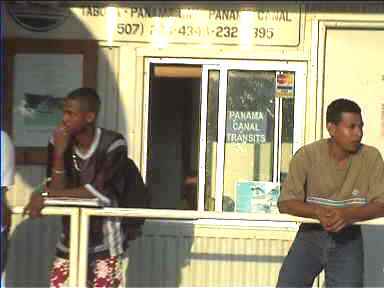 |
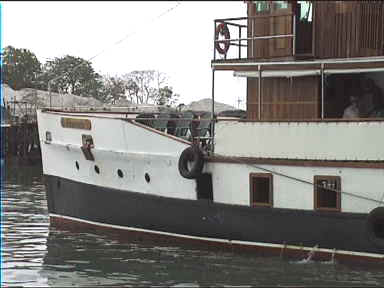 |
|
|
There are a lot of people already waiting and we board our boat, the 'Ismoralda'. It is big enough to hold us all with ease. The captain speaks good English (he might have been American), and the guide speaks Spanish and Spanglish over the PA system. At the first set of locks (called the Miraflores Locks) there is big interest among the passengers as to what is about to happen and all assemble on deck and jostle for the best viewpoint. The locks themselves are enormous and all large ships in the world are built with the maximum dimensions of the Panama canal in mind. There are four sets of locks at Miraflores, two after each other and two side by side. There is a Web-Cam at Miraflores which can be accessed at http://www.panamacanal.com
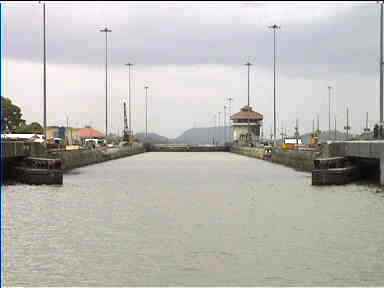 |
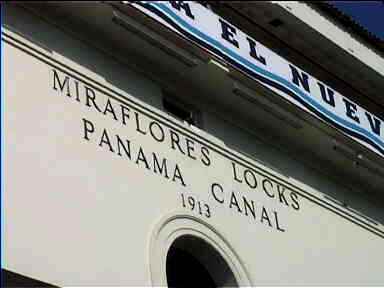 |
|
|
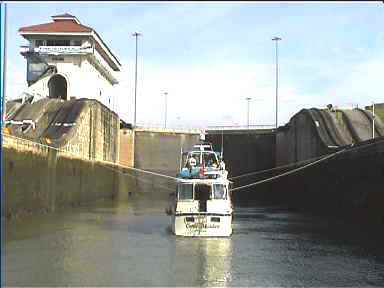 |
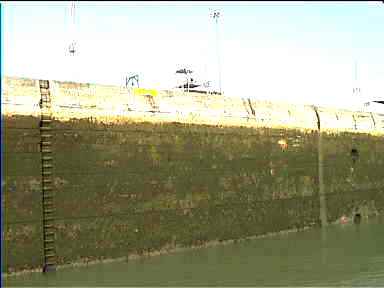 |
|
|
Filling the locks with water occurs very quickly, and all boats need to be tied with ropes in order that they don’t hit the walls of the locks or some other ship. Our lock is practically empty, and is seems we are lost in the vast space. There is a dive ship, a tugboat and us. After Miraflores locks we continue on to Miraflores lake and then the next set of locks, called Pedro Miguel Locks.
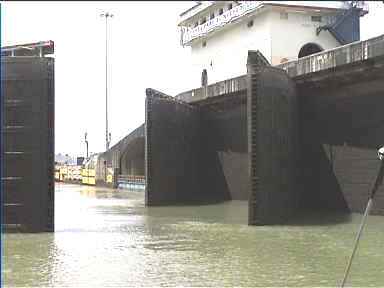 |
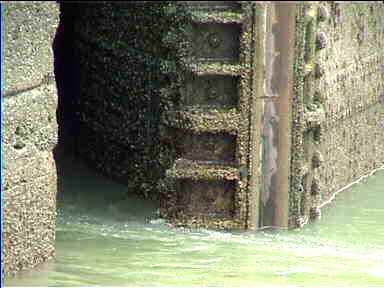 |
|
|
After that comes the Gaillard Cut, which was the most difficult part of the Canal to be built. The water here is not very deep, and although the Canal seems wide enough, the ships need to stay on course to avoid running aground. For this purpose, there are black and white markers on the surrounding hills. Each ship passing the Canal must also take a Pilot of the Canal on board to assist with navigation.
Next we reach the Continental Divide, and this is where we turn to go down back to Panama City. We pass over a large bridge at Panama City, to pass by the Causeway and get a great view of the City. With all it's skyscrapers, Panama City looks much like a modern US city. On the boat, we get a Panama Canal Transit certificate made, complete with our picture on it.
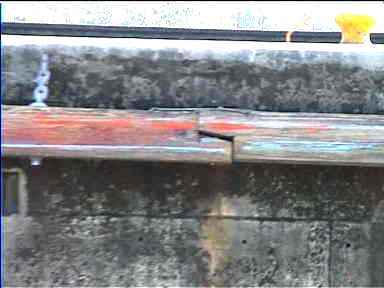 |
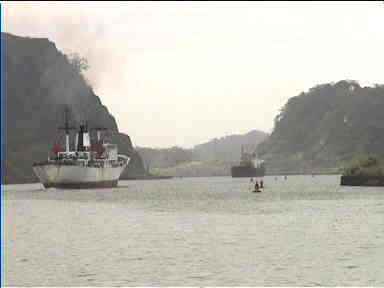 |
|
|
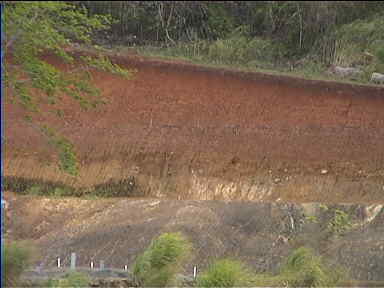 |
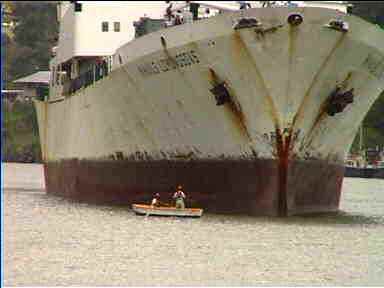 |
|
|
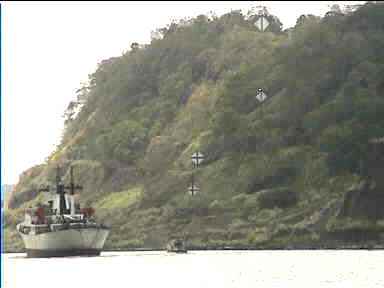 |
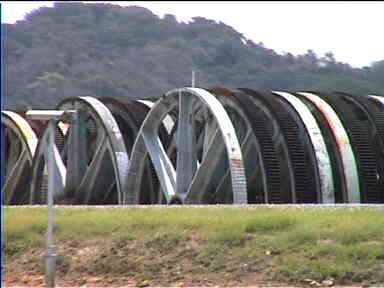 |
|
|
By now, my cold is breaking out and I'm feeling sicker. We take a taxi to the Causeway, to a restaurant called 'el Puerto'. It is quite expensive and we settle for just a drink. It is very hot by now and there is no taxi to be seen to take us back to the city. We have one called by the restaurant and he wants 4$ to drive us back. I offer 3 and he just drives off in a huff. What an idiot! We walk back to 'el Ranchito' restaurant and there we find a taxi which will take us to Via Espana for some more shopping for 3$.
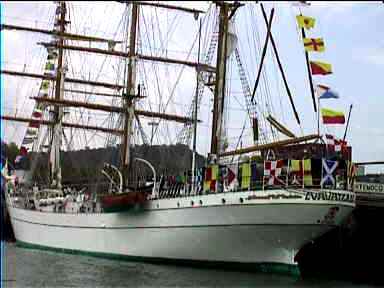 |
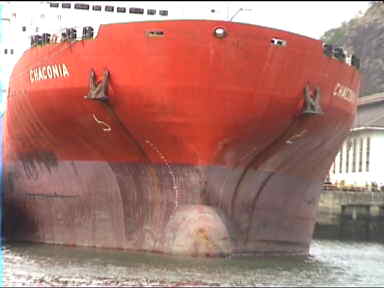 |
|
|
Annewien is shopping for single-day contacts but doesn't find any. CD's are about the same price as Switzerland, so I don't buy any. We get some Aspirin and handkerchiefs as my cold is breaking out. It's raining cats and dogs by now. We take a taxi to the airport via Holiday Inn to get our luggage (15$). The porters at the Hotel wish us a hearty goodbye, the taxi needs to pay toll tax twice. I change clothes at the airport, moving from my swimming trunks to long pants. We can't find a place to eat a small snack, so we go for chips and chocolate.
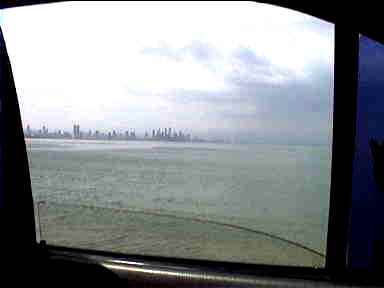 |
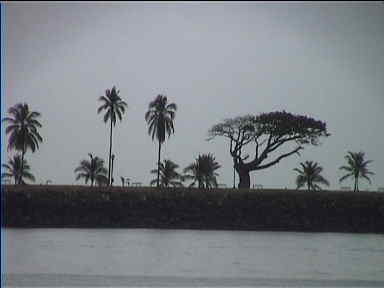 |
|
|
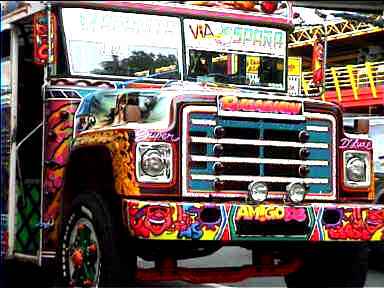 |
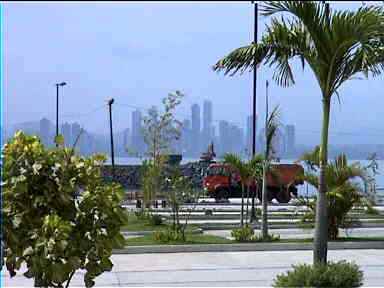 |
|
|
Our Copa flight takes off almost on time, by now it is dark outside. Just a short while after taking off from the ground, the plane seems to lose power and I get a sickening feeling that something is wrong and we are going to crash over Panama City in the dark! It seems that the engines do not develop enough thrust to allow the plane to gain any altitude. We look at each other, concerned. But then the situation seems to recover and everything returns to normal.
We are served a meal of Pork and Pasta and eventually land in Caracas after an uneventful flight. Just after passing Passport Control I notice that the foreign exchange counter is located before the desks, so I try to go back through passport control. It is quite a hassle to go back, the officials are suspicious and I need to do some explaining. One of them even wants me to pay 'airport tax' to pass. Eventually they let me through and I change Traveller's Cheques to the local Bolivares (1$ = 710 Bs). Venezuela has no coins, only paper money, all of which has exactly the same size. So a wad of money may either be next to worthless or worth very much, depending on the denominations!
By the time I return, Annewien has found that they have an Airport Taxi, which is prepaid at counters inside the arrival hall. In this way, people new to Caracas can avoid getting cheated. LP states that the airport is dangerous territory outside the terminal, especially at night, but I nevertheless propose to leave the terminal to find a taxi outside, a driver meets us and offers a ride to town. After a lot of haggling we settle to about 15$ (which is cheaper than airport taxi). But the car is a disaster, it is an old American model, with dark tinted windows and exhaust fumes entering the car! The driver is a large black guy and he engages in some trivial conversation with me. It is a long drive to town, about 25km, along the road we saw hills covered with small houses and the sight was quite unique.
Our Hotel is at Sabana Grande, the 'Palace Plaza Hotel'. I'm expecting to see a good hotel after our experience in Guatemala City, but it is 3* fare. The lady there doesn't want to recognize our hotel voucher because she doesn't have any corresponding booking, and makes a fuss about leaving a credit card imprint. We say we'll clear the problem next morning. The room is ok, with a/c, TV. I'm feeling so bad that I decide to take antibiotics before going to bed. I definitely do not want to be sick now. We are both very tired after such a long day and fall asleep quickly.